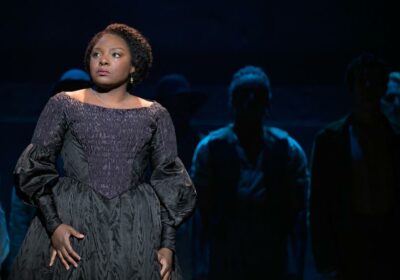‘Paradise Square’ Review: A Belabored History Lesson of a Broadway Musical

The body can sometimes say more than words, but even the most expressive moves cannot make a coherent case for “Paradise Square.” The blunt and belabored history lesson of a new musical set in Manhattan’s Five Points, and produced by Garth Drabinsky, purports to be a fable of American race relations. But while conflicts between the neighborhood’s Black and Irish residents at times come thrillingly to life through dance, “Paradise Square” is wrong-footed from the jump.
Named for an all-are-welcome saloon in the downtown slum, the Broadway musical presents a clash of cultures inspired by true events. Irish immigrants and Black Americans are jostling to survive in a city of harsh promises and a country on the brink of Civil War. Two young men walk into a bar, one fresh off the boat from Ireland (A.J. Shively) and another (Sidney DuPont) who’s just escaped slavery on the Underground Railroad. And it’s showtime, fellas! Both are made to sing and dance for their room and board.
Their rivalry sets up a false equivalency between the challenges of working class immigrants and those of the formerly enslaved that the story neither sufficiently complicates nor resolves. Instead, “Paradise Square” puts a host of stock characters in a broadly sketched historical setting, piles on the plot, and hopes for contemporary resonance. The result is a tiresome mess.
Supported by a formidable dance ensemble, the ongoing face-off between the two men is at least a vibrant showcase for propulsive choreography from Bill T. Jones. Shively’s newcomer joins his countrymen in an impressive tap whirlwind inspired by Irish step dance, while DuPont’s runaway brings an earthy, sometimes modern, style that leads from the center. This dialogue of movement is by far the show’s most eloquent.
The musical, which arrives on Broadway after more than 10 years in development and as many creatives with a hand in shaping it, is front-loaded with contrived set-up (the book is credited to Christina Anderson, Craig Lucas and Larry Kirwan, who also conceived the show and wrote additional music). The saloon has to pay up or close, men are getting drafted off to war and a dance competition with a cash prize could be just the solution. There’s also a baby on the way, two sets of lovers separated by the Mason-Dixon, a top-hatted villain and a piano-playing drunk.
That would be Stephen Foster, the 19th century songwriter famous for such tunes as “Oh! Susanna” and “Camptown Races,” whose racist appropriations of Black influence also figure fleetingly into the story. Foster’s songs are credited in part for inspiring the score for “Paradise Square,” with music by Jason Howland and lyrics by Nathan Tysen and Masi Asare. But despite a sometimes promising blend of Irish textures with soulful gospel, there’s little to distinguish the score from other contemporary musicals that likewise hew to the middle-of-the-road.
For all its spring-loaded set-up, “Paradise Square” quickly runs out of steam, sputtering through a reprise-heavy second act that somehow feels both bloated and rushed. A near-total lack of characterization beyond their historical circumstance invites little emotional investment in the numerous people on stage. And their battle positions, drawn along racial lines, both strain credulity and flatten the dynamics “Paradise Square” aims to explore. While Irishmen decry fighting for a country they’ve just adopted, does it follow that all Black men would long to take up arms for one that enslaved them?
Amid its convoluted logic, “Paradise Square” has an invaluable asset in Joaquina Kalukango, who delivers an exhilarating, star-making performance as the iron-backed bar owner. In the fiery and show-stopping eleven o’clock number “Let It Burn,” as throughout her entire performance, Kalukango embodies a character that feels organic to personal conviction rather than simply connecting plot points. If only she weren’t alone.
The staging, by director Moisés Kaufman, can often feel like a churning exercise in traffic control, with all or most of the sizable ensemble cluttered onto designer Allen Moyer’s rotating black-scaffold set. There’s a random, almost chaotic, shuffle to the succession of scenes, where it’s anyone’s guess who might sing next and why. And despite its distinct historical setting, the production feels neither gritty nor transporting, or much like New York as compared to any other port city.
Only when “Paradise Square” clears the way for dance, and everything falls away between soles and the floor, does it strike anywhere close to the heart.
Source: Read Full Article